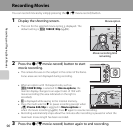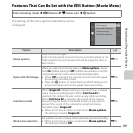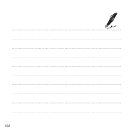
97
Recording and Playing Back Movies
B Notes About Recording Images and Saving Movies
The indicator showing the number of exposures remaining or the indicator showing the maximum
movie length flashes while images are being recorded or while a movie is being saved. Do not open
the battery-chamber/memory card slot cover or remove the battery or memory card while an
indicator is flashing. Doing this could result in loss of data, or in damage to the camera or the
memory card.
B Notes About Movie Recording
• Memory cards with an SD Speed Class rating of 6 or faster are recommended when recording
movies (F22). Movie recording may stop unexpectedly when memory cards with a lower Speed
Class rating are used.
• Optical zoom cannot be adjusted once movie recording begins.
• Rotate the zoom control during recording to enable digital zoom. Subjects can be magnified up to
4× the optical zoom ratio applied before movie recording began.
• There is some degradation in image quality when digital zoom is used. When recording ends,
digital zoom turns off.
• The sounds of zoom control operation, zoom, autofocus lens drive movement, vibration
reduction, and aperture operation when brightness changes may be recorded.
• The following phenomena may be seen in the monitor while recording movies. These
phenomena are saved in the recorded movies.
- Banding may occur in images under fluorescent, mercury-vapor, or sodium-vapor lighting.
- Subjects that move quickly from one side of the frame to the other, such as a moving train or car,
may appear skewed.
- The entire movie image may be skewed when the camera is panned.
- Lighting or other bright areas may leave residual images when the camera is moved.
• Depending on the distance to the subject or the amount of zoom applied, subjects with repeating
patterns (fabrics, lattice windows, etc.) may have colored stripes (interference patterns, moire, etc.)
in them during movie recording and playback. This occurs when the pattern in the subject and the
layout of the image sensor interfere with each other; it is not a malfunction.


















